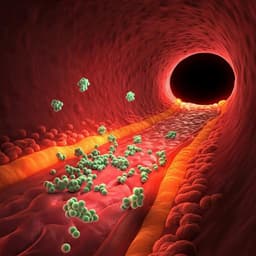
Agriculture
Characterization of phyllosphere endophytic lactic acid bacteria reveals a potential novel route to enhance silage fermentation quality
H. Zhou, S. Jia, et al.
Discover how phyllosphere endophytes can revolutionize silage fermentation in alfalfa, enhancing fermentation characteristics through specific lactic acid bacteria. This intriguing study by Hongzhang Zhou, Shangang Jia, Yu Gao, Xiaomei Li, Yanli Lin, Fuyu Yang, and Kuikui Ni explores the potential of *Pediococcus pentosaceus* EN5 to optimize fermentation quality.
~3 min • Beginner • English
Introduction
This study investigates whether phyllosphere endophytic bacteria, particularly endophytic lactic acid bacteria (LAB), contribute significantly to silage fermentation quality in alfalfa. The phyllosphere constitutes a vast microbial habitat hosting epiphytes (surface) and endophytes (internal), which can influence plant productivity, pathogen resistance, and nutrient cycling. In silage production, native phyllosphere microbes initiate fermentation; however, alfalfa often has low epiphytic LAB counts, low soluble carbohydrates, and high buffering capacity, leading to suboptimal natural fermentation. Exogenous LAB inoculants are commonly used but may have poor environmental adaptability and variable efficacy. The authors hypothesize that endophytic LAB, adapted to the plant’s internal environment, can drive improved ensiling outcomes and thus represent a valuable and underexplored inoculant source. The study aims to characterize endophytic diversity and functions, compare fermentation outcomes initiated by endophytes versus total phyllosphere bacteria, and validate selected endophytic LAB as silage inoculants.
Literature Review
Prior work recognizes the phyllosphere as a large, diverse microbial habitat influencing plant health and ecosystem processes. Phyllosphere microbes can confer pathogen resistance and participate in nitrogen and carbon cycling. In silage, complex microbial succession—including LAB, yeasts, molds, bacilli, and enterobacteria—determines fermentation quality. Alfalfa’s low epiphytic LAB counts and chemical properties often yield poor natural fermentation, prompting use of exogenous LAB inoculants with inconsistent performance due to environmental maladaptation. LAB are frequently detected as endophytes and can produce antimicrobial/antioxidant compounds; their coevolution within plants suggests enhanced environmental tolerance and potential to improve fermentation. Despite extensive studies on epiphytes, the diversity and role of endophytic communities in ensiling have been underexplored.
Methodology
- Sampling and isolation: Collected 58 healthy alfalfa samples from six Chinese regions. Established a culture-based resource of phyllosphere bacteria: epiphytes obtained by washing; endophytes by surface sterilization followed by tissue grinding. Cultured on LA, TSA, MRS, and GS media at 30 °C; isolated 795 strains (391 epiphytic, 404 endophytic). Identified taxa by 16S rRNA gene sequencing (27F/1492R), BLAST against NCBI 16S, and phylogeny via neighbor-joining.
- Community dynamics during ensiling: Prepared two fermentation groups from alfalfa: PB (natural phyllosphere microbiota) and EN (after surface sterilization to enrich endophytes). Ensiled and sampled at days 9, 30, 60. Characterized microbial communities using PacBio Sequel II full-length 16S rRNA sequencing. Processed reads (SMRTLink), clustered OTUs (97% similarity, UPARSE), taxonomic assignment (RDP Classifier, SILVA v138). Predicted functions via Tax4Fun (KEGG). Diversity indices (Mothur), PCA/PERMANOVA and RDA (Vegan), and co-occurrence networks (CoNet/Cytoscape, Gephi; Spearman |r| > 0.6, P < 0.05).
- Silage quality measurements: Determined pH, organic acids (HPLC), ammonia nitrogen (phenol-hypochlorite), dry matter (DM), crude protein (Kjeldahl), fiber (NDF/ADF), water-soluble carbohydrates (anthrone-sulfuric acid; sugars by HPIC). Microbial counts by plate methods for LAB, yeasts, molds, and E. coli.
- LAB strain selection and inoculation trials: Screened LAB from isolates for growth and acid production on MRS; selected eight LAB (four epiphytic, four endophytic) as inoculants at 1×10^6 CFU/g FM. Reported four treatments with improved fermentation versus PB: EP2 (Lactococcus lactis), EP3 (Lactiplantibacillus pentosus), EN5 (Pediococcus pentosaceus), EN6 (Lactiplantibacillus plantarum). Ensiled alfalfa for 7, 30, 60 days; profiled communities (PacBio), diversity, RDA linking microbes to fermentation metrics, random forest for discriminative taxa, and co-occurrence networks.
- Carbohydrate utilization: Measured soluble sugar composition in fresh alfalfa (HPIC). Assessed LAB sugar utilization using Biolog AN MicroPlate; calculated average well color development and a composite utilization score weighted by alfalfa sugar composition.
- Genomics: Sequenced genomes of EP2, EP3, EN5, EN6 using ONT; assembled with Canu and circularized (circlator). Annotated genes (Prodigal), tRNA/rRNA, repeats, prophages, CRISPR, genomic islands, secondary metabolite clusters, promoters; functionally annotated against Nr, Swiss-Prot, TrEMBL, KEGG, eggNOG; screened CAZymes (CAZy), transporters (TCDB), resistance (CARD), virulence (VFDB), etc. Compared EN5 to a reference P. pentosaceus genome (NZ_CP065723.1) for carbohydrate transport/metabolism genes and CAZymes. Conducted pan-genome analysis of 89 P. pentosaceus genomes (BPGA; core/accessory/unique genes; KEGG categories; pan-genome phylogeny).
Key Findings
- Culture-derived diversity: From 58 alfalfa samples, 795 isolates (391 epiphytes, 404 endophytes) spanning 216 species, 78 genera, 4 phyla. Dominant phyla: Pseudomonadota 46.54%, Bacillota 32.08%, Actinomycetota 20.50%. Endophyte-dominant genera: Bacillus (20.79%), Pseudomonas (19.55%), Curtobacterium (5.45%), Microbacterium (5.45%). Epiphyte-dominant genera: Pseudomonas (19.44%), Microbacterium (8.18%), Pantoea (7.93%), Enterococcus (7.67%), Exiguobacterium (7.67%), Curtobacterium (5.12%). Shared 69 species across 36 genera; 80 species unique to endophytes (including Pediococcus), 67 unique to epiphytes.
- Community dynamics during ensiling: EN group exhibited significantly lower alpha diversity (Shannon) than PB at days 9, 30, 60 (P < 0.05), and stabilized earlier (by day 9). PB shifted from Staphylococcus and Pantoea to Enterococcus, Levilactobacillus, Lactiplantibacillus; by day 60, LAB and certain anaerobes (Irregularibacter, Sedimentibacter, Mobilisporobacter) dominated. EN was dominated by Lactiplantibacillus, Weissella, Levilactobacillus; Pediococcus appeared only in EN; Enterococcus more abundant in PB. Co-occurrence networks indicated different key LAB: PB (Lactococcus, Enterococcus, Leuconostoc), EN (Lactiplantibacillus, Weissella, Lactococcus, Leuconostoc, Pediococcus).
- Silage quality: EN vs PB showed significantly higher DM, WSC, CP (P < 0.05) and lower EE (P < 0.05); fermentation showed lower NH3-N, acetic acid, pH, and higher lactic acid (all P < 0.05). Enterobacteria and yeasts were significantly lower in EN (P < 0.05). Predicted functions in EN: higher glycolysis, pentose phosphate pathway, and L-lactate dehydrogenase (P < 0.05), higher acetate kinase; lower butanoate pathway and butyrate kinase; butyric acid lower in EN (2.97 ± 1.55 vs 6.23 ± 2.84 g/kg DM; P = 0.33).
- Inoculant trials: Among four reported treatments (EP2, EP3, EN5, EN6), EN5 (P. pentosaceus) showed decreasing Shannon diversity (others increased or stable), and distinct beta-diversity. RDA showed P. pentosaceus positively correlated with lactic acid (LA), acetic acid (AA), crude protein (CP), and negatively with pH and NH3-N; L. pentosus correlated positively with LA and negatively with pH but showed negative and positive correlations with CP and NH3-N, respectively. Random forest identified P. pentosaceus and L. pentosus as top discriminative taxa. EN5 and EN6 communities remained dominated by Pediococcus and Lactiplantibacillus, respectively, indicating strong assembly effects. Co-occurrence networks: Pediococcus had predominantly negative correlations only in EN5, suggesting stabilization via competitive exclusion.
- Carbohydrate utilization: Fresh alfalfa soluble sugars were mainly L-fucose, D-mannose, D-cellobiose, sucrose, α-D-glucose. EN5 displayed the highest composite utilization of alfalfa sugars, with strong use of D-mannose, α-D-glucose, and D-cellobiose, despite lower growth/acid production in MRS broth compared to EP3/EN6.
- Genomics: Genome sizes—EP2 (L. lactis) 2.35 Mb; EP3 (L. pentosus) 3.58 Mb; EN5 (P. pentosaceus) 1.84 Mb; EN6 (L. plantarum) 3.29 Mb. Transporter genes: EN5 had fewer total transporters but was enriched for PTS Man family components—two Man-PTS IIB genes (absent in other LAB) and two IID genes (others had one), supporting mannose/fructose/sorbose transport. CAZymes: EN5 uniquely contained CBM35, CBM4, GT32, GT8 relative to epiphytic strains; vs reference P. pentosaceus (NZ_CP065723.1), EN5 uniquely had CBM35, CBM4, GT32. Pan-genome of 90 P. pentosaceus isolates comprised 5630 gene families with 998 core genes; phylogeny reflected plant- and animal-associated clades. EN5 harbored 9 unique proteins, including SecB, potentially enhancing stress tolerance and nutrient uptake. An antibiotic resistance gene associated with penam and cephalosporin was identified in EN5.
Discussion
The findings support the hypothesis that phyllosphere endophytes, particularly endophytic LAB, can enhance silage fermentation quality in alfalfa. Compared to natural phyllosphere-driven fermentation (PB), endophyte-driven fermentation (EN) rapidly established LAB-dominated communities (Lactiplantibacillus, Weissella, Pediococcus), produced more lactic acid, lowered pH, suppressed undesirable microbes (enterobacteria, yeasts), and preserved nutrients (higher CP, WSC; lower NH3-N). Functional predictions indicated stronger glycolysis and lactate dehydrogenase capacity and reduced pathways linked to butyrate formation, consistent with observed acid profiles. Inoculation with endophytic LAB confirmed their regulatory role: P. pentosaceus EN5 and L. plantarum EN6 exerted strong community assembly effects and improved fermentation quality. EN5’s superior in silico and experimental utilization of host-relevant sugars (mannose, glucose, cellobiose), enriched Man-PTS components, and unique CAZymes (CBM35/CBM4, GT32/GT8) provide mechanistic explanations for its competitive advantage in ensiling despite modest performance in standard MRS broth. Network analyses indicated Pediococcus can act as a central, negatively interacting node in EN5, implying stabilized, less complex communities favorable for consistent fermentation. Collectively, endophytic LAB exhibit niche-adapted traits that can be harnessed to improve ensiling outcomes and may outperform epiphytic or exogenous inoculants due to better adaptation to plant-internal nutrient landscapes.
Conclusion
This study charts the diversity and function of alfalfa phyllosphere endophytes and demonstrates that endophyte-driven fermentation improves silage quality versus natural phyllosphere communities. Selected endophytic LAB, particularly Pediococcus pentosaceus EN5, act as effective inoculants, driving LAB-dominant, stable communities with superior fermentation profiles. Genomic analyses reveal adaptations supporting efficient carbohydrate transport and metabolism (notably Man-PTS enrichment and unique CAZymes) and potential stress tolerance (SecB), explaining their performance advantage. These results propose phyllosphere endophytes as a novel route for developing robust, host-adapted microbial inoculants for ensiling. Future work should include in planta studies to understand endophyte recruitment and niche-specific genome diversity, and thorough safety assessments (e.g., antibiotic resistance gene presence and potential transfer) before agricultural deployment.
Limitations
- Functional predictions were inferred from 16S rRNA-based tools (Tax4Fun) rather than metagenomes/metatranscriptomes, which may limit accuracy of pathway activity assignments.
- Only four LAB inoculant treatments with positive outcomes were reported; broader validation across strains, environments, and forage types is needed.
- The dominance and performance of endophytic LAB were evaluated in lab/controlled ensiling; in planta recruitment mechanisms and ecological constraints remain unresolved.
- Presence of an antibiotic resistance gene in EN5 raises safety concerns; potential horizontal transfer and impacts on animal and environmental health require investigation.
Related Publications
Explore these studies to deepen your understanding of the subject.







